Imagine a wintry Wednesday morning in Norway, chilly and bleak outside, yet inside the Newton Room at Grønnåsen School in Bodø, and Class 6a is buzzing with excitement. A giant robot table is a focal point in this room, beckoning eager young minds to enter.
BODØ/NORWAY: Upon entering the room, the students are amazed by the giant robot table, and from there, they can explore the lab, the main room, or the amphitheatre. Today, our Newton Teacher Ingjerd Staurbakk takes the class to the amphitheatre, the perfect spot to start the day. The students quickly fill all the levels with excitement while their class teacher Karina Størkersen sits down to observe from the sidelines.

CIRCUMFERENCE. Newton Teacher Ingjerd Staurbakk tells the pupils that they will do calculations and programming based on the circumference of the wheel of a LEGO® SPIKE™ Prime robot. All photos: FIRST Scandinavia
Calculating circumference
The day's program is about geometric calculations, programming, and running a SPIKE™ Prime robot in the "Robots and Circumference" mathematics module. The Newton Module lasts four hours and consists of three activities that build on each other.
Ingjerd starts by asking the class, "What is the circumference of a circle?". A student named Liam raises his hand and answers, "It's finding out how far it is around something."
"Yes," replies Ingjerd, "and there are many ways to calculate the circumference. What different units of measurement can you use?"
Jarmann replies, "For example, millimeters, centimeters, meters, and kilometers."
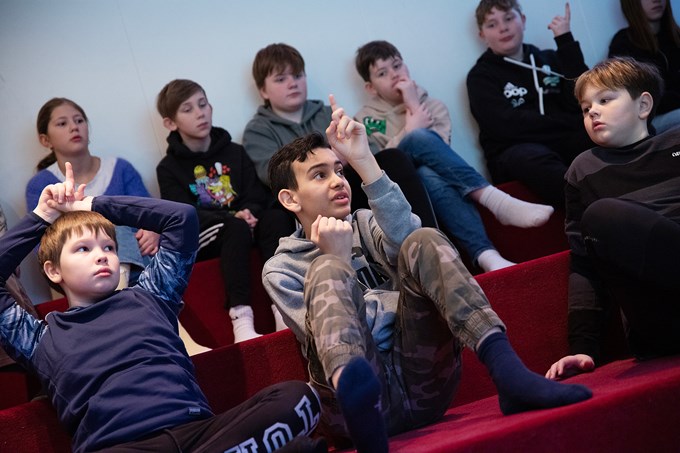
HANDS UP. Students are encouraged to participate in the Newton Room experience. Top, from left: Sofia, Elias, Kristian, Gabriel, and Sverre Bottom, from left: Markus, Jarmann, and Liam.
Group work
Now, it's time for the pupils to work in pairs on practical tasks throughout the day, starting with activity 1. They'll calculate the circumference of a circle and test how far a robot will travel with different numbers of wheel rotations. The pupils can use various tools to calculate the distance; on each group table, there is a box containing a tape measure, string, ruler, calculator, tape, scissors, and stationery to use. Ingjerd walks around explaining and gently guiding the students spread out at desks and on the floor.
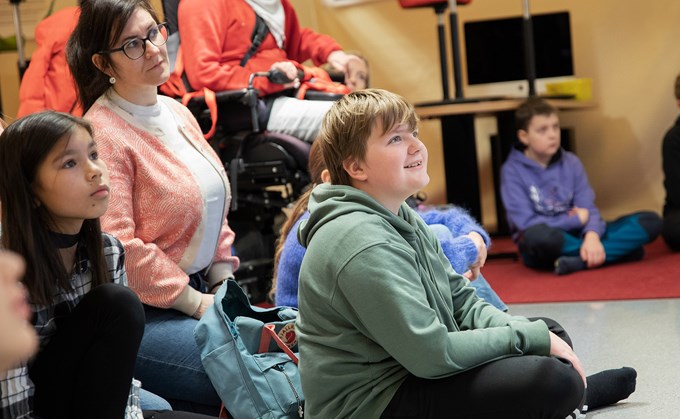
CLASS PRIDE. Class teacher Karina Størkersen is proud of her dedicated group of pupils.
They have been looking forward to it
The group has been eager to return to the Newton Room. "They have been so excited to go. The last time they were here was in the fourth grade, and they still remember it well. They are a friendly and engaged group of pupils," says Karina, visibly proud of her students.
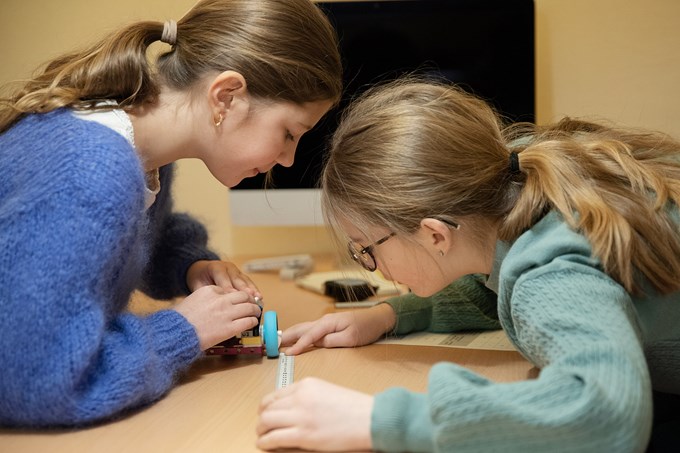
MEASUREMENT. Sofia (left) and Signe uses the tape measure method to find the circumference of the robot wheel.
Some students even remember the group they were with the last time they were in the Newton Room. When asked why it was so memorable for her, "We get to program and think for ourselves," answers Sofie.
The students return to the amphitheatre, discussing what they have done. The groups have come up with several different measurements of the circumference of the robot's wheel, and an engaged class is trying to find out which ones are best.
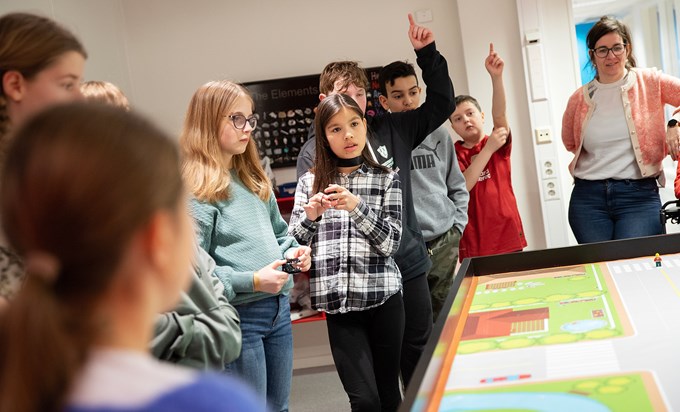 AT THE ROBOT TABLE. The main character of this activity is smaller than usual. Using mathematical calculations, the task is to come closest to the LEGO figure with the robot.
AT THE ROBOT TABLE. The main character of this activity is smaller than usual. Using mathematical calculations, the task is to come closest to the LEGO figure with the robot.
The LEGO figure
After lunch, it's time for activity 2, and the students gather at the robot table. Ingjerd explains the following task: program the robot to drive as close as possible to a LEGO figure before stopping. The students must determine what information they need to calculate the number of wheel rotations for this task. The students must discuss and agree on a strategy before coming to the robot table to try out their proposed solution.

ACTIVITY TWO. Emilie (left) and Kaja put their theory to the test with their calculations.
They measure, discuss, and program before eventually taking the robots to Ingjerd to test. The atmosphere is buzzing, and shouts of triumph and frustration can be heard around the table.
Advanced calculations
We meet Sverre and William. They are delighted with the results of their programming. "We came just one millimeter away!" Sverre smiles happily.
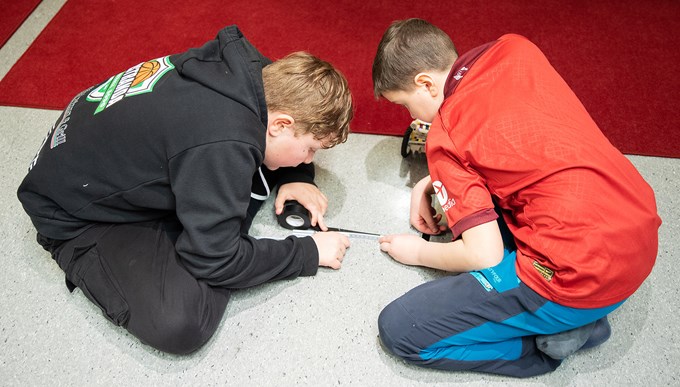
CAREFUL PLANNING. Sverre (left) and William are optimistic about collaborating and teamwork to solve complex math problems.
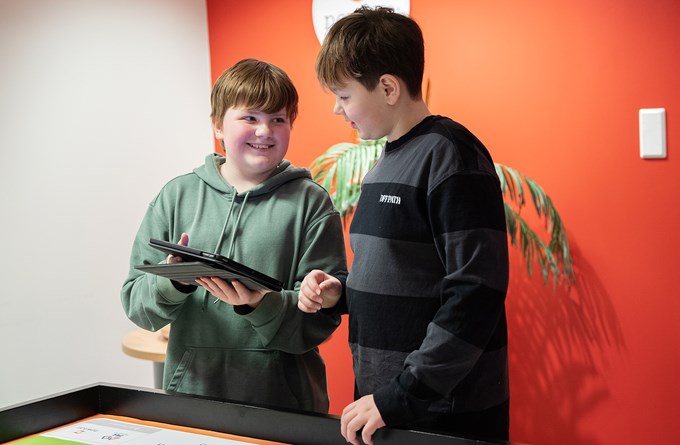
SUCCESS. Liam and Kristian are delighted with their efforts.
Liam and Kristian are also very pleased with their efforts. In their first attempt, they came two centimeters away. "But now we've done some advanced mathematics, and we came to just 1.2 centimeters away, so now we're happy," the pair says. They run across the room to get their water bottles but stop to check how Markus and Elias, who are on the floor programming, are doing.

MAKING SHAPES. Kaja has programmed the robot to follow the shape she has taped on the floor.
In activity 3, "Tracing the Shape," each pair of students plan together and then tape a geometric figure of their choice on the floor. They program the robot to drive along the shape's perimeter on the floor.
Unlike traditional schools, a Newton Room is not about memorizing facts or following strict procedures. It's a place where students learn by doing, collaborating, and making mistakes. "What's good about learning mathematics this way?" asks our Newton Teacher.
"It's the fact that we get to work in teams and collaborate. You must learn from others because you probably don’t know everything yourself," add Liam and Kristian, excited about the day's advanced mathematics.
The students leave the Newton Room with memories of building robots, programming, and designing shapes. But more importantly, they leave with a renewed confidence and passion for learning about and exploring the world around them.
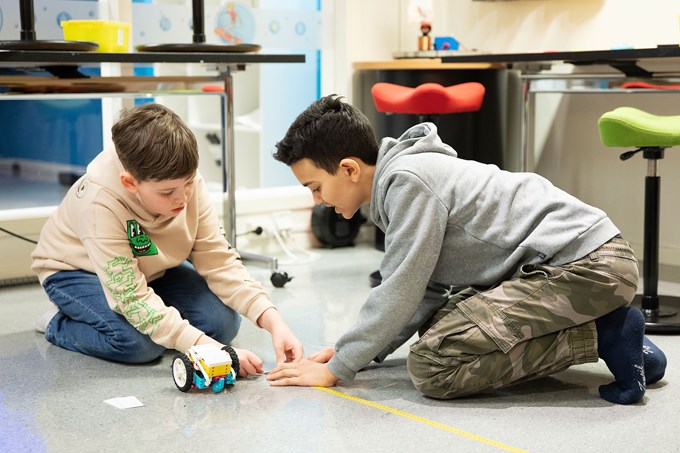
TEAM WORK. Gabriel (left) and Jarmann had a great day in the Newton Room with the SPIKE Prime robot and the rest of the class.